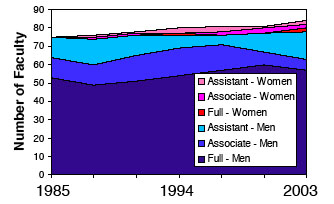


 |  |  | Mentoring |
 |
| Telemachus and Mentor |
| by Pablo E. Fabisch |
| from Les Adventures de Telemaque |
 |
| Caltech engineering faculty |
| distribution among men and women |
As of 1996, there were 124 tenured and tenure-track women EE professors at United States universities [8]. Of the top twenty departments, an informal scanning of their departmental Web pages yielded a total of 75 tenured and tenure-track women in EE. These numbers are not good, they show a wide distance between representation in the population and representation in engineering faculties, and the poor numbers play a major role in the poor numbers in student bodies. A field suffers when it fails to attract and encourage diverse talent.
Although many factors affect these statistics and a variety of approaches exist to improve them, arguably the means by which a small number of people can have the maximum impact is by encouraging, assisting, and supporting those who understand the value of diversity and wish to become leaders in academia. The importance of mentoring in science, mathematics, and engineering is known at the national level. In particular, in 1966 the White House established the Presidential Awards for Excellence in Science, Mathematics and Engineering Mentoring (PAESMEM). The program is administered on behalf of the White House by the National Science Foundation (NSF). The Program Director is Dr. Marilyn Suiter, who together with Stanford Dean of Engineering Jim Plummer provided a welcome and introduction to the workshop participants. PAESMEM identifies outstanding mentoring efforts/programs designed to enhance the participation of groups underrepresented in science, mathematics and engineering. The awardees serve as exemplars to their colleagues and are leaders in the national effort to more fully develop the nation's human resources in science, mathematics and engineering. The awards include funds to support the awardees' projects, including workshops, Websites, and developing and expanding mentoring programs. Dr. Suiter and several PAESMEM recipients (Brainard, Wadia-Fasceti, Mecartney, Muller, Denton, Gray) participated in the workshop.
A working definition of mentoring at PAESMEM is an interaction between a more experienced person and a less experienced person; it provides guidance that motivates the mentored person to take action. The PAESMEM program supports a research agenda on science and engineering workforce mentoring in cooperation with other programs. This includes the exploration of career mentoring in science, technology, engineering, and mathematics (STEM) Career Mentoring by NSF's Committee on Equal Opportunity in Science and Engineering (CEOSE), in partnership with PAESMEM, and implemented by AAAS/EHR (Yolanda George) with support from AAAS's Committee on Opportunities in Science (COOS). The project also builds on an earlier AGEP-based AAAS study group meeting. The goals are
This workshop contributed to the awareness of several of these issues in a core group of enthusiastic participants. It is hoped that these proceedings will add to the promulgation of these ideas and provide supporting material for mentors and mentees, current and future.